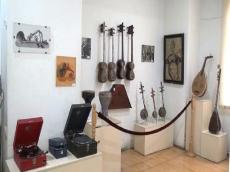|
|
TODAY.AZ / Arts & Entertainment
Traditional musical instruments on display in Tbilisi
13 April 2021 [11:45] - TODAY.AZ

By Azernews
By Laman Ismayilova
The Georgian State Museum of Georgian Folk Music and Musical Instruments has exhibited Azerbaijanis traditional music instruments. There is a special corner at the museum dedicated to the country's national music.
Speaking about the exhibits, the museum director Revaz Kotrikadze stressed that the Georgian people are showing great interest in Azerbaijani culture.
The country's traditional music instruments are much loved worldwide. There are many other local history museums in Georgia that store traditional musical instruments, household items, as well as other exhibits reflecting Azerbaijan's rich culture and history.
Saz is a stringed musical instrument of the lute type. The instrument has a pear-shaped body, a neck with tied sliding frets, a wooden soundboard and double or triple strings.
Kamancha is a bowed string instrument, which is widespread among Eastern and Central Asian peoples under a variety of names.
The art of crafting and playing with kamancha, a bowed string musical instrument, was included into the UNESCO Representative List of the Intangible Cultural Heritage of Humanity.
Tar or a long-necked plucked lute is traditionally crafted and performed throughout Azerbaijan
It is made from mulberry, walnut and pear trees, and the face of the instrument is made from cattle heart membrane. Its strings differ by thickness and composition.
The music and craftsmanship of Azerbaijani musical instrument, tar, was inscribed in the UNESCO list in 2012.
Balaban is a cylindrical-bore, double-reed wind instrument with seven finger holes and one thumb hole. When you play the balaban you should use fingers of both hands to open and close certain holes. It can be made of mulberry or other harder woods, such as walnut.
The silver ring, which is more than 2,000 years old, has been discovered during archaeological excavations in Bargoed village of Ujar region.
Ring with the bluestone imprinted the image of balaban. The word "balaban" combines two Azerbaijani-Turkish words "bal" and "ban".
"Bala" means small or fragile and “ban” is an archaism that means "voice".
The name of the first performer on this instrument in Azerbaijan is unknown. However, the oldest chang performer was poetess Mahsati Ganjavi. In his works, Nizami also notes the name of Nagisa, master harpist and composer of the royal court of King Khosrau II of Persia.
This musical instrument is one of the most beloved of the Azerbaijani people.
The balaban is included in the orchestras and folk instruments ensembles. The sounding of the balaban is clearly reflected in such music pieces as "Second Fantasy" (Uzeir Hajibayli), "Dance Suite" (Muslim Magomayev), "In Dreams" (Khalil Jafarov), etc.
Oud is a pear-shaped stringed instrument with 11 or 13 strings grouped in 5 or 6 courses. Four strings of the musical instrument were likened to the four elements of nature: fire, water, earth, air. It was often depicted in the works of miniature painting.
URL: http://www.today.az/news/entertainment/204996.html
 Print version
Print version
Connect with us. Get latest news and updates.
See Also
- 05 May 2025 [19:00]
Puppet and Theatrical Art of Czech Republic highlighted in Baku - 05 May 2025 [15:41]
Farid Kazakov's dance captivates audience in Turkiye - 05 May 2025 [13:26]
Azerbaijan demonstrates its rich craftsmanship on Carpet Weavers' Day - 05 May 2025 [12:03]
Int'l Carpet Festival showcases finest handmade creations - 05 May 2025 [11:23]
Ganja State Philharmonic holds concert dedicated to eminent cultural figure - 05 May 2025 [09:30]
Nine Senses Fest Int'l Yoga Festival wraps up - 02 May 2025 [15:39]
Azerbaijan to be represented at third Fujairah International Oud Forum - 02 May 2025 [15:00]
Weaving Future: Inese Baranovska on living tradition of carpets - 02 May 2025 [14:16]
Young talents dazzle in Austria - 02 May 2025 [13:19]
Honored Artist Nijat Kazimov holds seminar on theater art
Most Popular
 Public hearings resume in high-profile trial of Armenian citizens accused of war crimes
Public hearings resume in high-profile trial of Armenian citizens accused of war crimes
 Baku condemns ‘unfriendly’ Russian ban on Azerbaijani parliamentarian
Baku condemns ‘unfriendly’ Russian ban on Azerbaijani parliamentarian
 Armenian Church went all-in
Armenian Church went all-in
 Friend or foe? Russia undermines its own alliances in post-Soviet space
Friend or foe? Russia undermines its own alliances in post-Soviet space
 Pakistan records second-hottest April in 65 years
Pakistan records second-hottest April in 65 years
 Kenya hosts Azerbaijan’s deputy minister for first-ever political consultations
Kenya hosts Azerbaijan’s deputy minister for first-ever political consultations
 Orthodox community in Azerbaijan is important factor in interstate relations with Russia - President Ilham Aliyev
Orthodox community in Azerbaijan is important factor in interstate relations with Russia - President Ilham Aliyev
